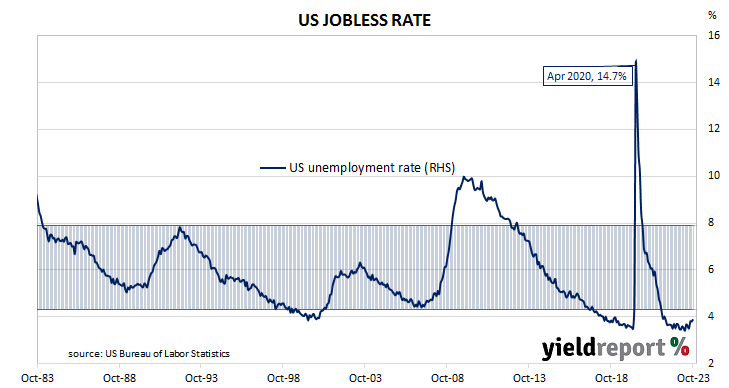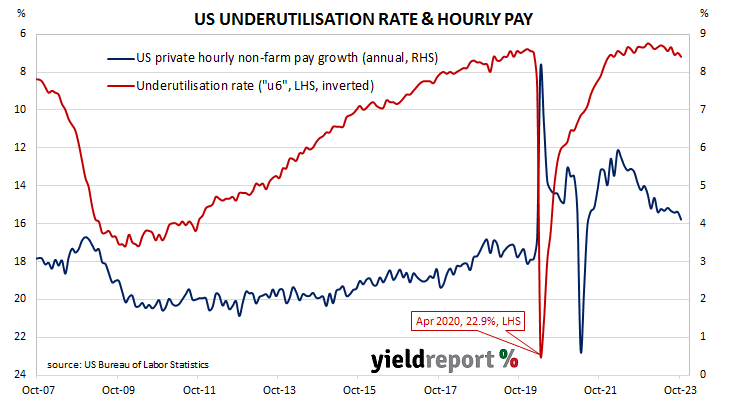Summary: Non-farm payrolls up 150,000 in October, less than expected; previous two months’ figures revised down by 101,000; jobless rate ticks up to 3.9%, participation rate slips to 62.7%; Westpac: US labour market in robust structural health, although heat coming out; employed-to-population ratio falls to 60.2%; underutilisation rate up; annual hourly pay growth slows to 4.1%.
The US economy ceased producing jobs in net terms as infection controls began to be implemented in March 2020. The unemployment rate had been around 3.5% but that changed as job losses began to surge through March and April of 2020. The May 2020 non-farm employment report represented a turning point and subsequent months provided substantial employment gains which continued through into 2021 and 2022. Changes in recent months have been generally more in line with the average of the last decade.
According to the US Bureau of Labor Statistics, the US economy created an additional 150,000 jobs in the non-farm sector in October. The increase was less than 168,000 rise which had been generally expected and about half the 297,000 jobs which had been added in September after revisions. Employment figures for August and September were revised down by a total of 101,000.
The total number of unemployed increased by 146,000 to 6.506 million while the total number of people who were either employed or looking for work decreased by 202,000 to 167.728 million. These changes led to the US unemployment rate ticking up from September’s figure of 3.8% to 3.9% while the participation rate slipped from 62.8% to 62.7%.
“Overall, the US labour market is still in robust structural health, yet it is evident that the heat has come out and downside risks for employment and household incomes are forming,” said Westpac Head of International Economics Elliot Clarke.
US Treasury yields fell significantly on the day, especially at the short end. By the close of business, the 2-year yield had shed 15bps to 4.84%, the 10-year yield had lost 9bps to 4.57% while the 30-year yield finished 3bps higher at 4.77%.
In terms of US Fed policy, expectations of a lower federal funds rate in the second half of 2024 hardened materially. At the close of business, contracts implied the effective federal funds rate would average 5.34% in December, 3bps more than the current spot rate, 5.345% in January and 5.33% in March. November 2024 contracts implied 4.51%, 82bps less than the current rate.
One figure which is indicative of the “spare capacity” of the US employment market is the employment-to-population ratio. This ratio is simply the number of people in work divided by the total US population. It hit a cyclical-low of 58.2 in October 2010 before slowly recovering to just above 61% in late-2019. October’s reading declined from 60.4% to 60.2%, some way from the April 2000 peak reading of 64.7%.
Apart from the unemployment rate, another measure of tightness in the labour market is the underutilisation rate and the latest reading of it registered 7.2%, up from 7.0% in September. Wage inflation and the underutilisation rate usually have an inverse relationship and hourly pay growth in the year to October slowed from 4.3% to 4.1% after revisions.



